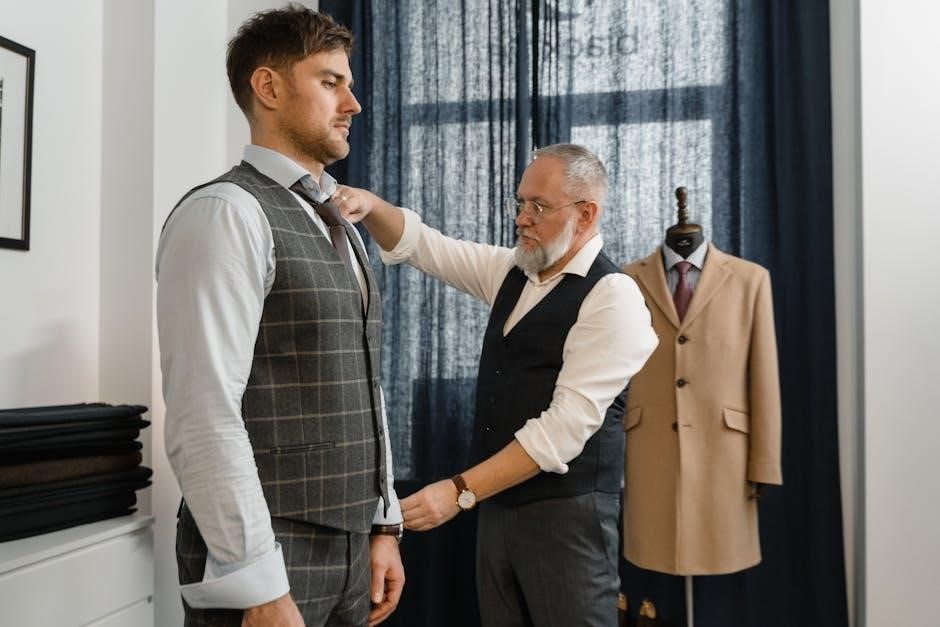Tailoring is a cornerstone profession in WoW Classic, allowing players to craft cloth armor, bags, and other essential items. It relies on cloth dropped by humanoid mobs, making it accessible to all classes. Tailoring is not only vital for gear progression but also offers lucrative opportunities for gold making through crafting in-demand items. This guide will explore the ins and outs of this versatile profession, helping you master it from level 1 to 300.
Overview of Tailoring in WoW Classic
Tailoring is a primary profession in WoW Classic, focusing on crafting cloth armor, bags, and other essential items. Tailors use cloth dropped by humanoid mobs across Azeroth to create gear for classes like Mages, Priests, and Warlocks. The profession is widely accessible, as cloth can be obtained without a gathering profession, making it versatile for any player. Tailoring becomes increasingly valuable at higher levels, with recipes for epic gear and large storage bags. It also offers opportunities for gold making by crafting in-demand items for other players. This profession is both practical and profitable, making it a popular choice for many in WoW Classic.
Importance of Tailoring for Crafters and Players
Tailoring is a vital profession for both crafters and players in WoW Classic, offering unique benefits that enhance gameplay and economic opportunities. Crafters can create high-demand items like cloth armor, bags, and shirts, making it a reliable source of income. Players benefit from access to crafted gear that improves performance in raids and PvP. Tailors can also support other professions, such as Enchanting, by crafting materials needed for spells and enhancements. The ability to craft storage bags is particularly valuable, allowing players to manage inventory more effectively. This profession strikes a balance between practicality and profitability, making it indispensable for both individual progression and guild contributions in Azeroth.

Materials and Resources
Tailoring in WoW Classic revolves around crafting with cloth, a primary material dropped by humanoid mobs. Key resources include linen, wool, silk, mageweave, and runecloth, essential for creating armor, bags, and other items. These materials vary in quality and rarity, determining the craft’s outcome and value. Efficiently gathering or purchasing cloth is crucial for advancing in the profession and producing high-demand items for players and the market.
Where to Farm Cloth in Azeroth
Cloth is a cornerstone resource for tailors, dropped by humanoid mobs across Azeroth. Key farming spots include the Plaguelands, Silithus, and high-level dungeons. For linen cloth, focus on early zones like Westfall and Loch Modan. Wool cloth is abundant in areas such as the Hinterlands and Hillsbrad Foothills. Silk cloth drops reliably in zones like Stranglethorn Vale and the Cape of Stranglethorn. Runecloth, the rarest and most valuable, is primarily found in the Western and Eastern Plaguelands, as well as Silithus. Efficient farming requires targeting specific zones based on your skill level and the type of cloth needed; This ensures a steady supply for crafting armor, bags, and other essential items.
Essential Cloth Types for Tailoring
In WoW Classic, tailors rely on specific cloth types to craft armor, bags, and other items. Linen Cloth is the starting material, used for basic recipes. Wool Cloth becomes essential for mid-level crafting, while Silk Cloth is needed for higher-tier items like robes and pants. Mageweave Cloth is used for advanced recipes, including bags and epic gear. Finally, Runecloth is the rarest and most valuable, required for top-tier armor and crafting the coveted Robe of the Void. Each cloth type plays a critical role in progressing through the tailoring skill tree, ensuring players can craft gear for themselves or sell on the auction house for gold.

Tailoring Trainers and Locations
Tailoring trainers are found in major cities like Stormwind, Orgrimmar, and Undercity. Josef Gregorian in Undercity teaches Horde players, while Alliance trainers are in Stormwind and Ironforge.
Master Tailors for Artisan Tailoring
To specialize in Artisan Tailoring, players must seek out specific Master Tailors. For the Horde, Josef Gregorian in Undercity teaches the Artisan techniques, while Alliance players can learn from Eric Schlitz in Ironforge. Reaching level 35 and achieving 200 Tailoring skill is required to unlock this advanced training. Artisan Tailoring introduces recipes for high-end materials like Mageweave and Runecloth, essential for crafting superior cloth armor and bags. These trainers are pivotal for progressing beyond the Journeyman level, enabling tailors to create items that are highly sought after by players for both functionality and aesthetics.

Trainer Locations for Horde and Alliance
Tailoring trainers are located in major cities for both factions. For the Horde, trainers can be found in Undercity, Orgrimmar, and Thunder Bluff. Alliance players can locate trainers in Stormwind, Ironforge, and Darnassus. These trainers are available from level 5 and teach the basics of Tailoring. Additional trainers are scattered throughout Azeroth, ensuring accessibility for players to learn and advance their skills. Notably, Undercity and Stormwind each have multiple trainers, making it easy for players to find one. These locations are essential for unlocking new recipes and progressing through the Tailoring profession.
Leveling Tailoring from 1 to 300
Mastering Tailoring from 1 to 300 requires a focused approach, using linen, wool, and higher-tier cloths to craft optimal recipes, ensuring efficient skill progression.
Step-by-Step Guide to Leveling Efficiency

Start by crafting Bolts of Linen Cloth using linen cloth until you reach skill level 70. This is the foundation for all tailoring progress. Next, focus on creating Linen Bracers and Linen Belt to push your skill to 100. Transition to Woolen Cloth at level 70, crafting Woolen Bracers and Woolen Belt to reach 120. At level 120, switch to Silken Thread and Mageweave Cloth, crafting Mageweave Pants and Mageweave Gloves to efficiently reach 200. Finally, use Runecloth to craft Runecloth Pants and Runecloth Gloves, ensuring a smooth progression to 300. Optimize by farming cloth in high-drop zones or buying from the Auction House to save time.
Optimal Recipes for Skill Progression
Begin with Bolts of Linen Cloth (1-70), using linen cloth to create stacks for later use. Transition to Linen Bracers and Linen Belt (70-100), ensuring steady skill gains. At level 100, craft Woolen Bracers and Woolen Belt (100-120) to maintain momentum. Next, focus on Silken Thread items like Mageweave Pants (120-150) and Mageweave Gloves (150-180). Finally, use Runecloth to craft Runecloth Pants (180-220) and Runecloth Gloves (220-300). These recipes provide the most efficient progression, minimizing material waste and ensuring consistent skill increases. Prioritize farming cloth in high-drop zones or purchasing from the Auction House to accelerate your crafting journey.
Crafting Gear and Items
Crafting high-quality cloth armor, versatile bags, and essential items is central to Tailoring. These goods are vital for character utility and in high demand in the economy.
Best Cloth Armor Recipes for All Classes
Tailors can craft a variety of cloth armor pieces, each tailored to specific class needs. Popular recipes include the Runecloth Robe, ideal for mages and warlocks, and Mageweave Pants, perfect for druids and priests. These armor pieces often require Runecloth or Mageweave Cloth, which can be farmed from high-level humanoids. Recipes like the Mooncloth Vest or Felcloth Hood are sought after for their high stats and versatility. Crafting these items not only aids in character progression but also meets the demand for reliable gear. Tailors can optimize their crafting by focusing on recipes that offer the best stat bonuses, ensuring their creations are in high demand across Azeroth.
Creating Storage Bags for Inventory Management

Tailors can craft essential storage bags, which are invaluable for managing inventory. Recipes like the Linen Cloak Bag, Woolen Carpet Bag, and Runecloth Bag provide increasing storage space. These bags require specific cloths, such as Linen Cloth, Wool Cloth, or Runecloth, along with thread. Crafting bags is a practical way to help players organize their items and free up space in their inventory. Higher-level bags, like the Mageweave Bag or Felcloth Bag, offer more slots and are highly sought after by players. Tailors can craft these bags to meet the constant demand for inventory solutions, making it a profitable and useful skill for both personal convenience and gold-making opportunities.
Tailoring and Gold Making
Tailoring offers substantial gold-making opportunities through crafting high-demand items like bags, armor, and exclusive shirts, which are highly sought after by players for convenience and aesthetics.

Monetizing Your Tailoring Skills
Monetizing your tailoring skills in WoW Classic is highly rewarding due to consistent demand for cloth armor, bags, and exclusive cosmetic items. By crafting high-demand goods like bags, which are essential for inventory management, you can generate significant gold. Additionally, crafting rare armor sets or shirts, which are purely cosmetic, can attract wealthy players seeking unique appearances. Understanding market demand and pricing on your server’s Auction House is crucial. Tailors can also undercut competitors to ensure quick sales. Pairing Tailoring with Enchanting further enhances profitability, as leftover materials can be disenchanted for valuable reagents. With strategic planning, Tailoring becomes a reliable gold-making profession.
Market Demand for Tailored Items
In WoW Classic, tailored items remain in high demand due to their utility and rarity. Cloth armor, particularly for classes like Mages and Priests, is sought after for its stats and availability. Bags, especially larger ones like 16-slot and 18-slot, are universally needed for inventory management, making them a consistent seller. Cosmetic items, such as shirts, also attract players looking to customize their appearances. Additionally, crafted gear for level , like epic sets, commands high prices. The demand spikes during leveling phases and raid preparation, as players gear up. Tailors who anticipate server trends and focus on high-demand items can capitalize on these opportunities, ensuring steady gold income throughout the game.
Leave a Reply